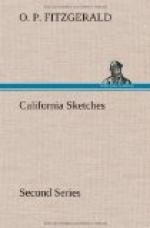The very bad Indian, placing his feet upon the attenuated bridge of doom, makes a few steps forward, stumbles, falls into the whirling waters below, and is swept downward with fearful velocity. At last, with desperate struggles he half swims, and is half washed ashore on the same side from which he started, to find a dreary land where the sun never shines, and the cold rains always pour down from the dark skies, where the water is brackish and foul, where no flowers ever bloom, where leagues may be traversed without seeing a deer, and grizzly bears abound. This is the hell of very bad Indians—and a very had one it is.
The worst Indians of all, at death, are transformed into grizzly bears.
The Digger has a good appetite, and he is not particular about his eating. He likes grasshoppers, clover, acorns, roots, and fish. The flesh of a dead mule, horse, cow, or hog, does not come amiss to him—I mean the flesh of such as die natural deaths. He eats what he can get, and all he can get. In the grasshopper season he is fat and flourishing. In the suburbs of Sonora I came one day upon a lot of squaws, who were engaged in catching grasshoppers. Stretched along in line, armed with thick branches of pine, they threshed the ground in front of them as they advanced, driving the grasshoppers before them in constantly increasing numbers, until the air was thick with the flying insects. Their course was directed to a deep gully, or gulch, into which they fell exhausted. It was astonishing to see with what dexterity the squaws would gather them up and thrust them into a sort of covered basket; made of willow-twigs or tule-grass, while the insects would be trying to escape; but would fall back unable to rise above the sides of the gulch in which they had been entrapped. The grasshoppers are dried, or cured, for winter use. A white man who had tried them told me they were pleasant eating, having a flavor very similar to that of a good shrimp. (I was content to take his word for it.)
When Bishop Soule was in California, in 1853, he paid a visit to a Digger campoody (or village) in the Calaveras hills. He was profoundly interested, and expressed an ardent desire to be instrumental in the conversion of one of these poor kin. It was yet early in the morning when the Bishop and his party arrived, and the Diggers were not astir, save here and there a squaw, in primitive array, who slouched lazily toward a spring of water hard by. But soon the arrival of the visitors was made known, and the bucks, squaws, and papooses, swarmed forth. They cast curious looks upon the whole party, but were specially struck with the majestic bearing of the Bishop, as were the passing crowds in London, who stopped in the streets to gaze with admiration upon the great American preacher. The Digger chief did not conceal his delight. After looking upon the Bishop fixedly for some moments, he went up to him, and tapping first his own chest and then the Bishop’s, he said:




